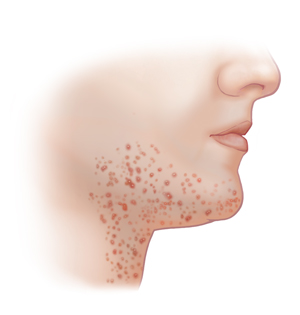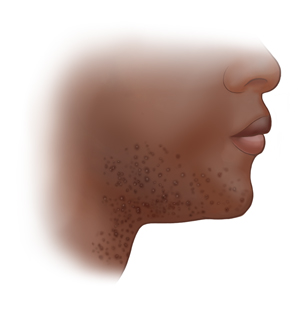Understanding Folliculitis
Folliculitis is when hair follicles become inflamed. Follicles are the tiny holes from which hair grows out of your skin. This skin condition can occur any place on the body where hair grows. But it’s often found on the neck, face, and scalp.
How to say it
foh-lihk-yoo-LI-tihs
What causes folliculitis?
An infection or irritation can cause this skin condition. Infectious folliculitis is often caused by a bacteria called Staph aureus. But it may also be caused by other bacteria or fungi. The condition can also happen from a wound or irritation of the skin. Shaving is a common cause. Some cases may come from taking certain medicines, such as those that treat acne.
Symptoms of folliculitis
This skin condition tends to develop quickly. It looks like little pimples on a base of a red, inflamed hair follicles. These bumps may ooze pus. They may also be:
-
Itchy
-
Painful
-
Red
-
Swollen


Treatment for folliculitis
Treatment depends on the cause of the inflammation. In some cases, this skin condition will go away on its own in a few days. But it may return. Treatment options include:
-
Warm compress. Putting a warm, wet washcloth on the inflamed skin may help. Don't reuse the same washcloth, because that may spread infection.
-
Medicine. Many skin (topical) and oral medicines are available. Antibiotics are used for bacterial infections. Antifungal medicines are best for fungal infections.
-
Good hygiene. Keeping the skin clean can help. Use a clean razor when shaving, and don't try to shave too closely. Prevent ingrown hairs after shaving. This can reduce folliculitis in the beard area. Stay away from any substances that bother your skin.
When to call your healthcare provider
Call your healthcare provider right away if you have any of these:
-
Fever of 100.4°F (38°C) or higher, or as directed by your provider
-
Pain that gets worse
-
Symptoms that don’t get better, or get worse
-
New symptoms
Online Medical Reviewer:
Michael Lehrer MD
Online Medical Reviewer:
Raymond Kent Turley BSN MSN RN
Online Medical Reviewer:
Tennille Dozier RN BSN RDMS
Date Last Reviewed:
5/1/2022
© 2000-2024 The StayWell Company, LLC. All rights reserved. This information is not intended as a substitute for professional medical care. Always follow your healthcare professional's instructions.